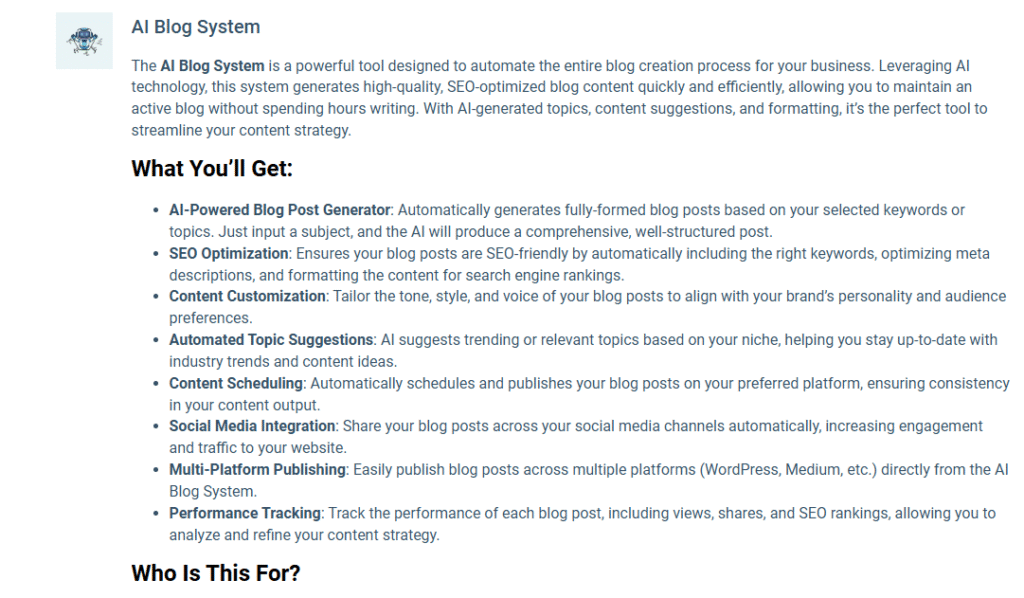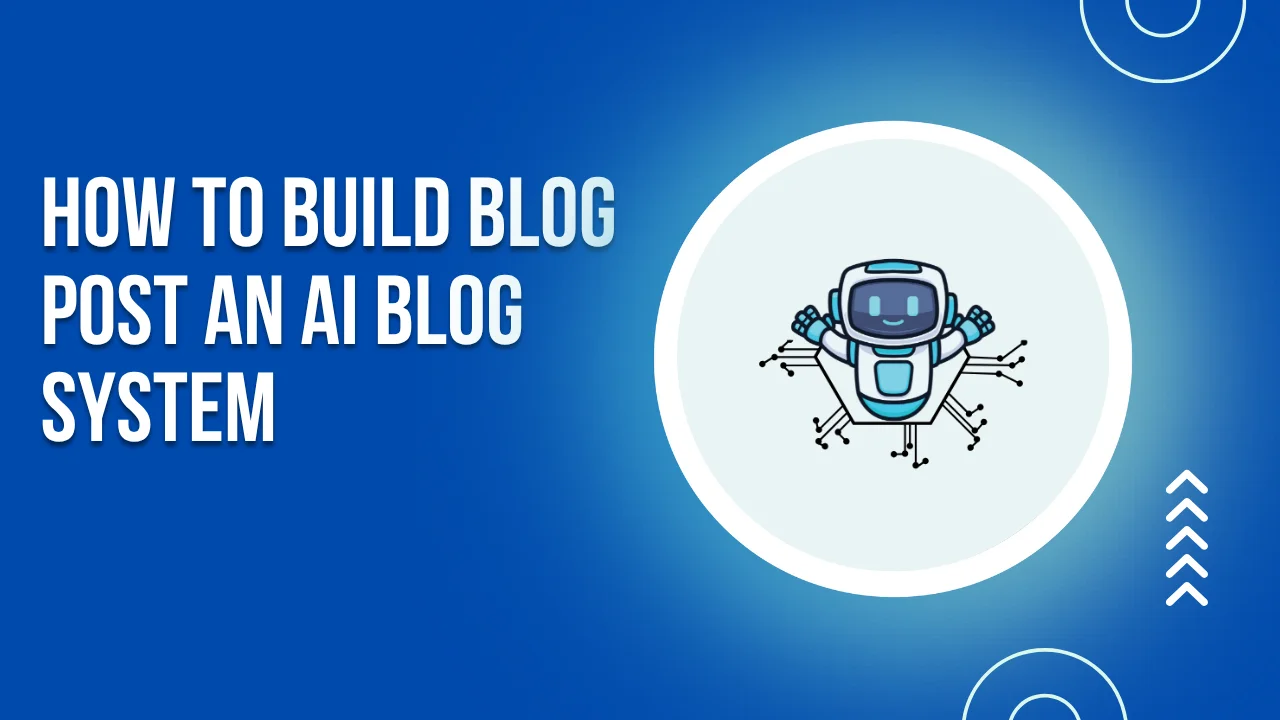AI Blog System is revolutionizing how businesses create and manage content. Whether you’re a beginner or looking to streamline your blogging process, using AI-powered tools can help you generate high-quality, SEO-optimized posts quickly and efficiently. In this full guide, we’ll walk you through how to build blog posts with an AI Blog System in 2025, covering everything you need to know to get started and succeed.

Ease of Use (Beginner-Friendliness)
One of the most important factors when choosing an AI Blog System is how easy it is to use — especially for beginners with little or no technical background. A good system should allow anyone to create and publish high-quality blog posts without needing to learn complex software or coding.
What Makes an AI Blog System Beginner-Friendly?
Here are key features that indicate ease of use:
- Simple Interface: A clean, intuitive dashboard that guides users step-by-step
- Pre-built Templates: Ready-to-use blog post templates make content creation faster
- Guided Prompts: The best tools offer helpful prompts or AI assistants that walk you through the content creation process
- One-Click Publishing: Direct integrations with platforms like WordPress simplify the final step
- Minimal Setup Required: You shouldn’t need to connect multiple tools just to get started
Some AI blog platforms also include onboarding tutorials, drag-and-drop editors, and live support — all of which can dramatically reduce the learning curve.
Content Quality
When building a blog using an AI Blog System, the quality of the generated content is one of the most critical factors to consider. High-quality blog posts are essential to attract readers, keep them engaged, and perform well on search engines.
What Defines Content Quality in an AI Blog System?
- Natural and Clear Language: The content should read naturally, without awkward phrasing or robotic sentences. Modern AI Blog Systems use advanced language models that create coherent and fluid text, making your blog posts sound like they were written by a professional writer.
- Accuracy and Relevance: Good AI-generated content stays on-topic and provides accurate information. It should understand the subject well enough to avoid factual errors and deliver value to readers.
- Engagement and Readability: The blog post should be easy to scan, with short paragraphs, clear headings, and bullet points where appropriate. Engaging content includes storytelling elements or examples to make the topic relatable.
- Tone and Style Adaptability: An effective AI Blog System allows you to customize the tone of your content to fit your brand’s voice — whether it’s formal, casual, or conversational.
- Avoidance of Keyword Stuffing: While SEO is important, the best AI Blog Systems balance keyword usage, including the focus keyword AI Blog System, naturally within the text to maintain readability.
Why Content Quality Matters
Poor-quality content can harm your website’s credibility and reduce traffic. Search engines like Google prioritize well-written, useful content that satisfies the user’s search intent. When you use an AI Blog System that produces high-quality content, you increase your chances of ranking higher and attracting loyal readers.
Pro Tip: Always Review and Edit
Although AI-generated content is improving rapidly, it’s essential to review and fine-tune the output. Adding personal insights, checking facts, and polishing the style will make your blog posts stand out even more.
SEO Optimization Features
In 2025, building a successful blog requires more than just great content — you need to ensure that your posts are optimized for search engines. An effective AI Blog System includes built-in SEO optimization features that help your blog rank higher on Google and drive organic traffic.
Key SEO Features to Look for in an AI Blog System
- Keyword Integration Assistance
A good AI Blog System helps you incorporate your focus keyword — in this case, “AI Blog System” — naturally within the title, headers, meta descriptions, and throughout the content. This helps search engines understand what your post is about without keyword stuffing. - Meta Titles and Descriptions
Many AI Blog Systems automatically generate SEO-friendly meta titles and descriptions. These elements appear in search engine results and can significantly influence click-through rates. - Readability and Content Structure
SEO-friendly blogs are easy to read and well-structured. AI tools often suggest improvements such as breaking up long paragraphs, adding bullet points, and using clear subheadings, all of which enhance user experience and SEO. - Internal Linking Suggestions
Linking to other relevant pages or blog posts on your website improves SEO by helping search engines crawl your site more effectively and keeping visitors engaged longer. - Schema Markup Support
Some advanced AI Blog Systems generate schema markup automatically, enabling rich snippets (like star ratings or FAQs) in search results, which can improve visibility and click rates. - Integration with SEO Plugins and Tools
Compatibility with popular SEO plugins like Yoast SEO or Rank Math allows you to further optimize your blog posts with detailed analytics and recommendations.
Why These Features Matter
Search engines reward content that’s well-optimized and user-friendly. By leveraging an AI Blog System with robust SEO features, you reduce the guesswork and technical barriers to ranking your blog posts high on Google’s search results pages.
Pricing and Plans
When choosing an AI Blog System for your blogging needs in 2025, understanding the pricing structure is crucial. The right system should provide good value while fitting your budget—whether you’re a beginner, a small business owner, or managing a larger content team.
Common Pricing Models for AI Blog Systems
What to Consider When Choosing a Pricing Plan
- Content Volume Needs
Estimate how many blog posts or words you will generate monthly to select a plan that meets your needs without overspending. - Access to Advanced Features
Higher-tier plans usually unlock SEO tools, plagiarism checkers, or API access, which may be essential as your blog grows. - Trial Period and Refund Policies
Look for AI Blog Systems that offer free trials or money-back guarantees so you can evaluate the platform risk-free. - Team Collaboration
If you work with writers or editors, check if the pricing plan supports multiple users and roles.
Integration with CMS (e.g., WordPress, Webflow)
A vital feature to consider when selecting an AI Blog System is how well it integrates with popular Content Management Systems (CMS) like WordPress, Webflow, or others. Seamless integration allows you to create, edit, and publish blog posts directly without switching between multiple platforms, saving time and improving workflow efficiency.
Why CMS Integration Matters
Most blogs today run on CMS platforms such as WordPress, which powers over 40% of websites globally. Integrating your AI Blog System with your CMS lets you:
- Publish Content Instantly
Generate content within the AI tool and push it directly to your blog, eliminating manual copying and formatting. - Maintain Consistent Formatting
The integration helps preserve styles, headings, images, and links so your posts look professional and uniform. - Streamline Content Management
Manage drafts, revisions, and scheduling in one place, making the entire blog publishing process smoother.
Popular CMS Integrations with AI Blog Systems
- WordPress
Many AI Blog Systems offer plugins or API integrations for WordPress, enabling one-click publishing and post management right from the AI platform. - Webflow
For designers and developers using Webflow, integration allows AI-generated content to be added to dynamic collections or pages without hassle. - Other CMS Options
Some AI tools also support Shopify blogs, Joomla, or even custom-built CMS via APIs, providing flexibility depending on your setup.
What to Look For in Integration Features
- Easy Setup: Look for integrations that require minimal technical skills to connect.
- Content Syncing: The system should sync drafts and published posts automatically.
- Formatting Control: Ability to control images, headings, and embedded media within the CMS.
- Scheduling: Some integrations allow you to schedule posts directly from the AI system.
AI Model or Engine Used
A key factor that determines the performance and quality of an AI Blog System is the underlying AI model or engine powering it. Understanding which AI technology your system uses can give you insights into content accuracy, creativity, and overall effectiveness.
Popular AI Models Behind AI Blog Systems
- GPT-4 and GPT-3.5 by OpenAI
Many leading AI Blog Systems leverage OpenAI’s GPT series, known for producing highly coherent and contextually relevant text. GPT-4, in particular, offers improved reasoning, creativity, and language understanding, resulting in better blog content. - Proprietary AI Engines
Some platforms develop their own AI engines tailored specifically for content generation. These may focus on niche areas or specialized writing styles. - Other Language Models (e.g., Google’s BERT, T5)
Although less common for blog writing, some systems incorporate models designed for understanding and processing language to improve content suggestions and SEO.
Why the AI Model Matters
The AI engine influences how naturally the content reads, how well it stays on topic, and its ability to follow instructions such as tone or style. More advanced models like GPT-4 can generate longer, more detailed, and nuanced blog posts, reducing the need for extensive editing.
How to Choose Based on AI Engine
- Quality vs. Cost: Advanced models often cost more to operate but produce higher-quality content.
- Use Case Fit: Some AI engines are better for technical writing, others for creative storytelling or SEO-heavy posts.
- Updates and Improvements: Check if the AI Blog System regularly updates its model to keep up with advances in AI.
Image & Media Support
In today’s digital landscape, engaging blog posts go beyond just text—they include images, videos, and other media to capture readers’ attention and improve content value. A robust AI Blog System should support easy integration of images and media to enhance your blog posts.
Why Image & Media Support Matters
- Improves Readability and Engagement
Visual elements break up large blocks of text, making posts easier to scan and more visually appealing. This keeps readers on your page longer, reducing bounce rates. - Boosts SEO Performance
Proper use of images with optimized alt text can improve your blog’s SEO rankings. Search engines value diverse content types that enrich user experience. - Enhances Storytelling
Videos, infographics, and images can illustrate complex concepts or data better than words alone, helping readers understand and retain information.
Features to Look for in AI Blog Systems
- Built-in Image Search and Suggestions
Some AI Blog Systems integrate royalty-free image libraries or recommend relevant visuals based on your blog topic, saving you time searching elsewhere. - Media Upload and Editing Tools
The ability to upload your own images, resize, crop, or add captions directly within the platform simplifies content creation. - Support for Various Media Types
Beyond images, look for support for videos, GIFs, and embedded social media content to diversify your posts. - Automatic Alt Text Generation
AI-powered alt text suggestions improve accessibility and SEO without extra effort.
Templates & Content Types
A versatile AI Blog System should offer a wide range of templates and support for multiple content types to help you create diverse and engaging blog posts efficiently. Templates act as a framework to speed up content creation, while content types allow you to tailor your posts to different formats and audiences.
Why Templates and Content Types Matter
- Save Time and Effort
Pre-designed templates provide ready-made structures for blog posts, such as how-to guides, listicles, reviews, or news updates. This helps beginners avoid the blank page syndrome and ensures consistent formatting. - Maintain Consistency
Templates ensure your blog posts follow a uniform style, improving your brand’s professional appearance and making posts easier to read. - Adapt to Different Audiences and Goals
Offering various content types lets you meet different reader preferences and content strategies, from educational articles to persuasive product reviews or entertaining stories.
Common Templates and Content Types in AI Blog Systems
- How-To Guides and Tutorials
Step-by-step instructions designed for readers looking to learn or solve problems. - Listicles
Numbered or bulleted lists that are easy to skim and highly shareable. - Product Reviews and Comparisons
Useful for businesses promoting products or services. - FAQs and Q&A Posts
Answer common questions your audience may have, boosting SEO with targeted queries. - News and Updates
Share timely information about your industry or business.
Customization and Flexibility
The best AI Blog Systems allow you to customize templates to suit your brand voice and style. You can also combine different content types in one post—for example, a how-to guide with embedded FAQs.
Multilingual Support
As the internet becomes increasingly global, having an AI Blog System with multilingual support is a significant advantage. This feature allows you to create blog content in multiple languages, expanding your reach to international audiences and improving accessibility.
Why Multilingual Support is Important
- Reach a Global Audience
Writing in different languages helps you connect with readers from various regions, boosting traffic and brand awareness worldwide. - Improve SEO for Different Markets
Multilingual blogs can rank in search engines across languages, increasing visibility in non-English speaking countries. - Maintain Consistency Across Languages
An AI Blog System that supports multiple languages ensures your content remains consistent in tone and style, no matter the language.
What to Look for in Multilingual AI Blog Systems
- Wide Language Coverage
Check if the system supports the languages relevant to your target markets — from major languages like Spanish, French, Chinese, and Arabic to niche regional languages. - Quality of Translation and Localization
Some AI systems generate content directly in the target language, while others translate from a base language. High-quality systems understand cultural nuances to avoid awkward or incorrect phrasing. - Easy Switching Between Languages
The interface should allow you to easily switch languages when creating or editing content without losing formatting or SEO settings. - Multilingual SEO Tools
The best AI Blog Systems offer SEO optimization features for each language, including keyword suggestions and metadata customization.
Performance Analytics
To maximize the effectiveness of your blogging strategy, it’s essential to track how your content performs. A quality AI Blog System offers built-in performance analytics tools that help you monitor key metrics, understand audience behavior, and optimize your future blog posts.
Why Performance Analytics Matter
- Measure Success
Analytics show you which blog posts attract the most traffic, engagement, and conversions, helping you identify what works best for your audience. - Improve Content Strategy
By analyzing performance data, you can refine your topics, keywords, and posting frequency to increase your blog’s impact. - Identify SEO Opportunities
Monitoring how your blog ranks on search engines and how visitors find your content helps you optimize SEO tactics continuously. - Track Audience Engagement
Metrics such as average time on page, bounce rate, and social shares give insights into how readers interact with your posts.
Key Performance Metrics Offered by AI Blog Systems
- Traffic and Visitor Sources
Understand where your visitors come from — organic search, social media, referrals, or direct traffic. - Keyword Rankings
Track how well your focus keyword, like AI Blog System, ranks over time in search results. - Engagement Metrics
Includes page views, session duration, comments, and shares. - Conversion Tracking
For blogs aiming to generate leads or sales, analytics can monitor call-to-action performance.
Integration with External Analytics Tools
Table of Contents
Many AI Blog Systems also integrate seamlessly with popular analytics platforms such as Google Analytics, allowing you to access more detailed reports and customize tracking.
Customer Support & Community
When investing in an AI Blog System, quality customer support and a vibrant user community are essential factors to consider. These resources ensure you get help when needed and can learn from others’ experiences to make the most of your blogging tool.
Importance of Customer Support
- Timely Assistance
Reliable customer support helps you resolve technical issues quickly, minimizing downtime and frustration. - Guidance and Training
Support teams often provide tutorials, FAQs, and onboarding to help you understand the system’s features and maximize its potential. - Personalized Help
For complex problems or custom setups, access to live chat, email, or phone support can be invaluable.
Value of an Active Community
- Peer Learning
User forums and social media groups allow you to exchange tips, content ideas, and troubleshooting advice. - Feature Requests and Feedback
Active communities often influence product development by suggesting new features and reporting bugs. - Networking Opportunities
Engaging with other users can lead to collaborations and partnerships.
What to Look For in Support and Community Features
- Multiple Support Channels
Ensure the AI Blog System offers various contact options like chat, email, and helpdesk tickets. - Comprehensive Knowledge Base
A well-organized library of articles, guides, and video tutorials speeds up self-service support. - Community Platforms
Look for official forums, Facebook groups, or Discord servers where users connect regularly.
By leveraging an advanced AI Blog System, beginners and seasoned bloggers alike can maintain an active, engaging blog that drives traffic, builds brand authority, and saves valuable time.
Start exploring AI Blog Systems today and take your blogging to the next level in 2025!






